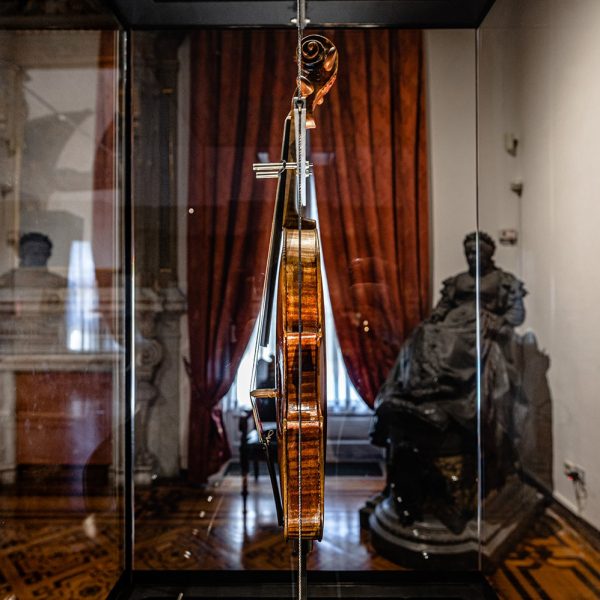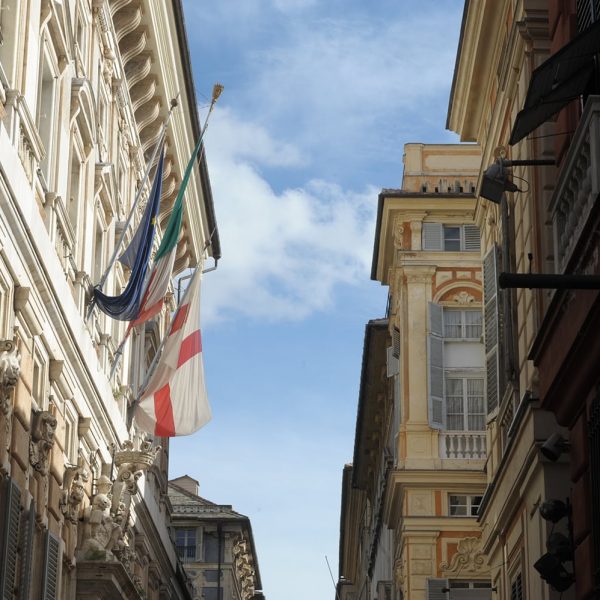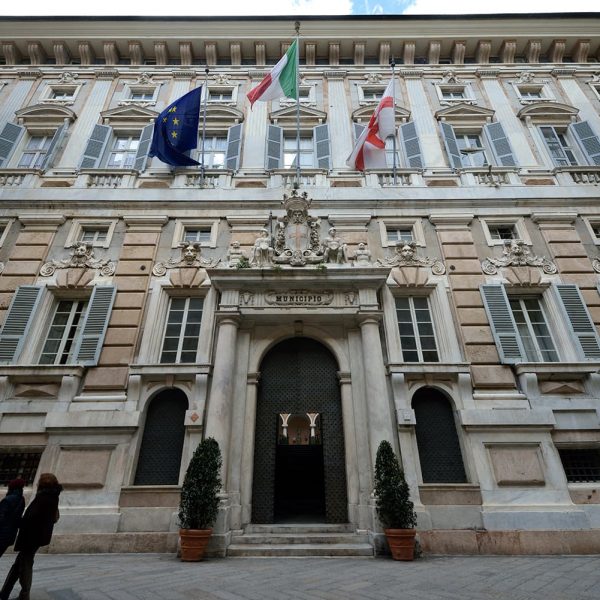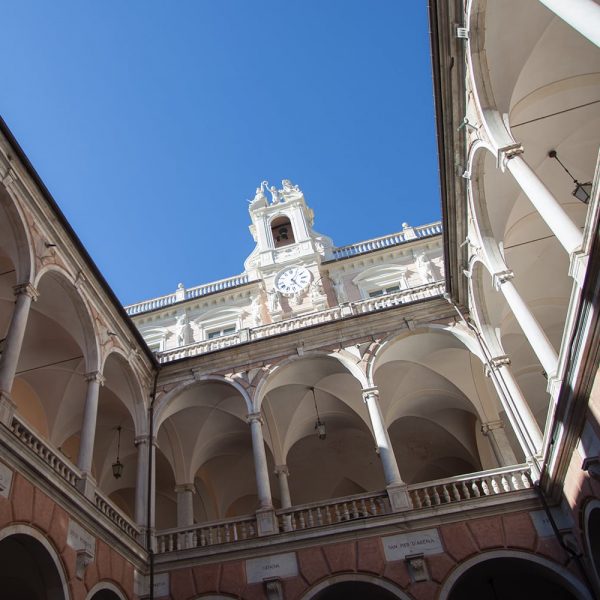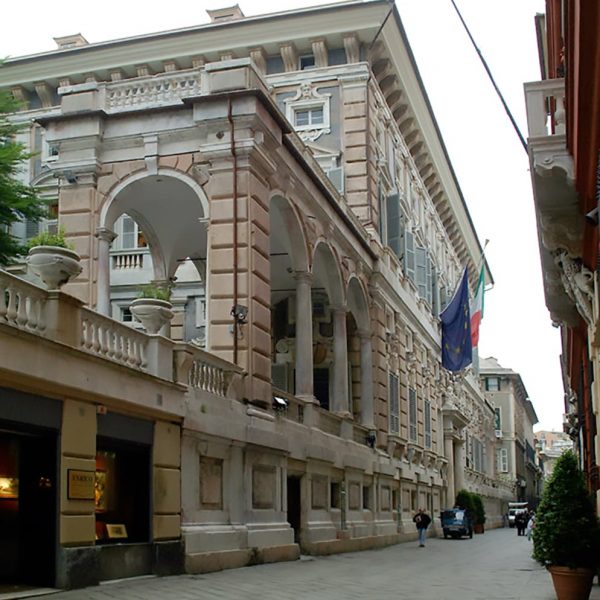
15. Palace of Lazzaro and Giacomo Spinola
25 March 2022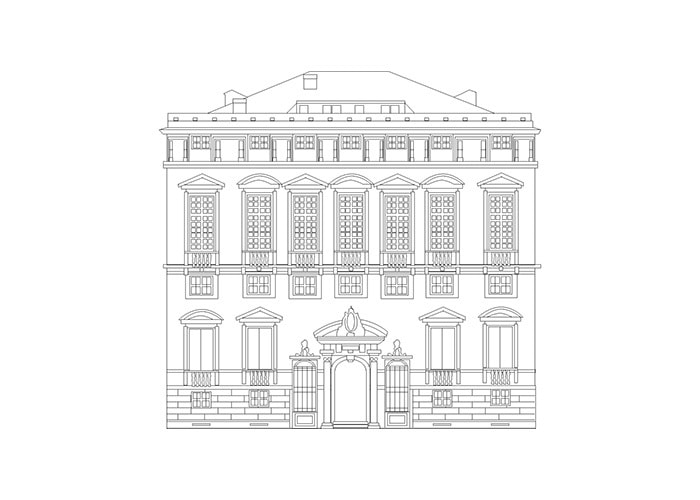
17. Palace of Baldassarre Lomellini
25 March 2022If in 1583, in the case of Cattaneo Adorno, two buyers had agreed to divide between themselves a site in Strada Nuova, in 1565 someone still opened a building yard on an area of about half a hectare with a street front three times wider than that of the other buildings.
We are in the second tract of the uphill side and the planned homogeneity of proportions sinks into the most prosaic reality: no matter how rich the Genoese merchants and financiers were, not many could afford to open a house in the new district. Some preferred to restore the family palace in the old centre, where they had roots and respect, and to invest in a new house in the country.
Nicolò Grimaldi, prince of Salerno, duke of Eboli, count of Rapolla and seigneur of Altavilla, and, principally, first banker of Philip II, was then welcomed to Strada Nuova.
The neighbourhood should not have been very friendly with someone who wanted to be called, “The Monarch”, but the completion of the street made great progress all in one go.
For three years however, from 1565 until the end of 1567, only the encumbrance of the levelling works progressed and needed about ten mules and three dumps outside the walls. It is true that this Grimaldi was still buying uphill land for an edification which, already swollen on the front, was spreading out even more in depth.
The project is by the brothers Giovanni and Domenico Ponzello and the supervision by the latter, an expert in fortifications, was to become precious in the works of consolidation of excavations and foundations. In fact, the high plinth with square blocks projecting on the limit of the street with permission of the Magistrate gives an imposing impression. Afterwards only Giovanni remained to direct the works and the unknown events of a project which evolved as the client extended the area with new acquisitions.
We are going to give a contemporary interpretation of this palace at number 9 which since the middle of last century has been the seat of the Town Hall. Actually the book by Rubens helps us very little, with only half a view and a plan of the portico (porch).
He had expressly declared that he was not going to work in princely palaces, not to speak of this one which, since 1569 became the property of Giovanni Andrea Doria, prince of Melfi and admiral of the Empire, haughty and disdainful also towards his fellow citizens and with him it became the property of his son Carlo, duke of Tursi, who left the name to the palace.
The view on the street and on the sides are anyway unchanged with a two order architectural structure of great monumental importance – rusticated ashlars in the first order and pilaster strips in the second – not without a typically Genoese coloured effect produced by the contrast between the white of the marbles and the pink stone of Finale and the grey slates at the bottom. The classical portal and the animal masks surmounting the windows are the celebrated work of Taddeo Carlone who took this work already advanced in the century, within the more inventive and extravagant mannerist culture.
The lateral loggias ordered by Giovanni Andrea Doria were designed by Carlone; they looked again onto the gardens which suggested an image of the luxurious cultivations of lemon and orange trees which were not the least pride of this dwelling.
Palazzo Tursi did not lack in those ascending perspectives owing to its closeness to the hill of Castelletto and it was also developed in depth; the possibility of looking onto a rear garden was only prevented by the adjoining church and convent of San Francesco, demolished during last century.
And hence the wonderful invention of a staircase scenery; a first central staircase goes from the portico to the endless covered courtyard, while another in the background starts the winding development of the lateral stairs up to the loggia of the first floor.
It is then an essentially architectural pomp, almost a second main façade for those who were admitted to the house, outside the living space distributed over several apartments without very original solutions. There is obviously the usual hall which had a late decor of the nineteenth century with Christopher Columbus in front of the kings of Spain, a rather academic work by Francesco Gandolfi: two other rooms have nineteenth century frescoes by Nicolò Barabino.
It had simply happened that the grand palace of the Monarch Grimaldi – probably in the severe Spanish taste – was the only one in “Strada Nuova” which remained without interior decoration.
The prince Doria had provided the interior fittings with precious tapestries and also did Vittorio Emanuele I di Savoia when he bought it – 1820 – for his Genoese stays. On this occasion the court architect Randoni elevated beyond the back wall the turret with the clock.
Two series of seventeenth century tapestries, a Flemish one with Stories of Alexander and an English one with Allegories of the Months, are now conserved in the reception rooms of the Town Hall together with some precious relics of the town among which the Ashes of Christopher Columbus and, famous all over the world, the violin of Nicolò Paganini.
It is the only palace in “Strada Nuova” which can boast a very happy history of recent developments (1961, Franco Albini architect) and the steepest position, with a sloping profile to the hill of Castelletto: new buildings for the Council Room and the offices of the Municipal administration masked from the high with hanging gardens on the roofs.
The building in front of this palace, at number 12, known as Palazzo delle Torrette, though dignified is not worth mentioning.
It was erected in 1716 by the architect Viano on the spare area which the Grimaldi family had bought to give breath to the entrance of such a dwelling, but it never had a real autonomy. Created with the function of dépendance it was also the screen which appeared leaving Tursi, holed in the middle by an arch in order to give access to the axis which maintained the place-name, but not the dignity of Vico del Duca.
Updated bibliography post 1998
E. Poleggi, Genova. Una civiltà di Palazzi, Cinisello Balsamo (Milano) 2002, pp. 80-83 (Palazzo di Nicolò Grimaldi (1564-1595))
E. Poleggi, L’invenzione dei Rolli, catalogo della mostra, Genova 2004.
P. Boccardo, Palazzo Tursi, in Musei di Strada Nuova a Genova, a cura di Raffaella Besta, Milano 2010, pp. 165-167.
The texts have been updated thanks to the INSIDE STORIES project financed with funds - Law no. 77 of 20 February 2006 "Special measures for the protection and enjoyment of Italian sites of cultural, landscape and environmental interest, included in the "World Heritage List", under the protection of UNESCO.
- PH. Studio Leoni
- PH: AFalcone



